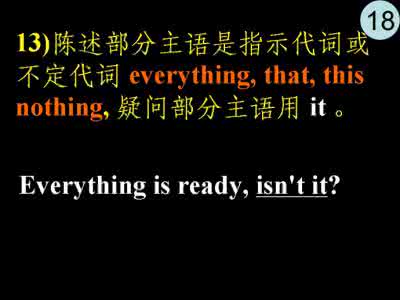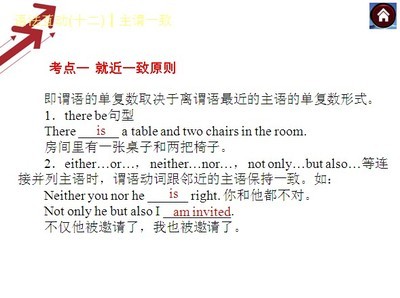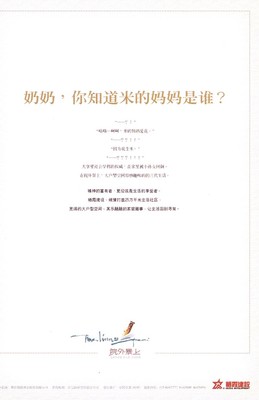一、反意疑问旬的构成
肯定的陈述句+否定的反意疑问。如:
That clock is show,isn't it?
否定的陈述句+肯定的反意疑问。如:
That clock isn' t show,is it?
肯定的陈述句+肯定的反意疑问。如:
That clock is show,is it?
否定的陈述句+否定的反意疑问。如:
That clock isn't show ,isn't it?
前两种形式是主要的,也是中学生必须掌握的:后两种形式使用场合较少,且一般用来表示讽刺、挑衅、愤怒这样的感情色彩,因此不可随便使用。
二、反意疑问句构成上的一些特例
1.使用疑问部分主语时要注意的情况。
(1)当陈述部分的主语是I,而句子又用来征询对方的意见时,反意疑问句中的主语用you。如:
I don't like English,do you?
I find math very interesting,don't you?
(2)当陈述部分的主语是
everybody, everyone, someone, no one,somebody, nobody, noone等合成词时,反意疑问部分中的主语往往用they,但亦可用he/she,尤其是在nobody等作主语,具有否定概念时。如:
Everyone enjoyed the party,didn't they?
Somebody borrgwed my pen yesterday,didn't they?
Nobody phoned while I was out,did they/he?
(3)当陈述部分的主语是不定代词everything,nothing,anything,something时,疑问部分的主语一般用it,不用they。如:
Everything seems all right now, doesn't it?
Nothing can stop us.can it?
(4)当陈述部分的主语是one时,疑问部分的主语可用one,也可用you。如:
one can t work all thetme,can one/you?
(5)当陈述部分的主语是动名词或动词不定式时,疑问部分的主语用it。
2.使用疑问句分动词时要注意的情况。
(1)当陈述部分为I结构时;疑问部分用aren’tI。
(2)当陈述部分的谓语动词是have时,要注意下列问题。
①表示“所有”时,有两种方法构成反意疑问部分:一是不用助动词do,一是借助助动词do。如
You have a new bike,don’t you?
He has a TV set,hasn't he?若陈述部分为否定式时,要避免出现前后作用方法不一致的现象。如:
Wrong:The house hasn't five rooms ,does it?
Correct:The house hasn't five rooms, has it?
Wrong:He doesn't have a new bike,has he?
Correct:He doesn't have a new bike,does he?
②当陈述部分的have不表示“所有”而表示其他含义时,反意疑问部分需用助动词do。如:
You often have supper at six ,don't you?
She had a good time yesterday, didn't she?
He has to go there ,doesn't he?
三、含有情态动词的句子。要注意的情况
1.当陈述部分含有情态动词oughtto时,反意疑问部分在英式英语中仍用oughtto,但在美式英语中常用助动词should。如:
The naughty child should be punished ,oughtn't he?
We ought to go there ,shouldntt we?
2.当陈述部分带有情态动词usedt0时,反意疑问部分可用usedt0或助动词did。如:
The Greens used to live in the country, usedn't they?
He used to smoke fifty cigarettes a day,didn't he?
3.当陈述部分带有情态动词must时,要注意下列问题。
(1)当陈述部分的must表示“必须”时,反意疑问部分用mustn’t。如:
You must work hard next term,mustn't you?
(2)当陈述部分的must表示“有必要”时,反意疑问部分则用Deedn’t。如:
He must go home rizht now,needn't he?
(3)当陈述部分的mustn't表示“禁止”时,反意疑问部分一般用must。如:
You mustn’t pIay football in the street,must you?
(4)当陈述部分的must表示“一定”、“想必”等推测意义时,反意
疑问部分不用must,而要根据陈述部分的不定式结构采用相应的助
动词或助动词形式。如:
She must be very tired, isn't she?
He must have waited here for a long time,hasn 't he?
The light is on.He must stay at home ,doesn't he?
4.陈述部分带有may时,反意疑问部分一般用mightn’t。若表示将来意义,则用won't。如:
That may be true,mightn't it?
They may be a little late,'won't they?
5.当陈述部分带有need或dare时,应注意其是实义动词还是情态动词。如果含有needn't,则反意疑问部分常用need,但有时也可用must。如:
He needs some help,doesn't he?
He needn't do that,must he?
You needn't go yet, need you?
四、判断陈述部分是不是否定式。要注意的几个问题
1.当陈述部分带有never,hardly,nobody,few,little,nowhere等否定词或半否定词时,反意疑问部分的动词用肯定形式。如:
He never goes to the cinema,does he?
Few of us were there at the moment,were they?
2.当陈述部分的否定词仅带有否定前缀和后缀时,那么该陈述部分按肯定句处理。如:
He looks unhappy,doesn't he?
He is careless with his money, isn't he ?
3.当陈述部分中的否定词否定的是一个词或一个短语,只形成部分否定时,陈述部分应按肯定句处理。如:
They live not far from us,don't the?
He has played a not important part, hasn't he?
五、陈述部分是复合句时要注意的几个问题
1.当陈述部分是一个带有that分句作宾语的主从结构时,疑问部分一般与主句的主谓一致。如:
He said that he was right,didn't he?
2.如果陈述部分的主句是I suppose,I believe,Ithink等结构时,反意疑问部分则往往与that分句中的主语和谓语动词保持对应关系,且要注意否定转移。如:
I don't think he is bright,is he?
3.如果主句的谓语是think,但主语不是第一人称,此时反意疑问部分仍与主句保持一致。如:

He thinks he will be late,doesn't he?
六、其他几种句型的反意疑问句
1.当陈述部分为therebe结构时,反意疑问部分的主语用bethere。如:
There aren't enough people to finish the work ,arethere?
There will be rain in the night,won't there?
2.祈使句反意疑问句的构成。
(1)以left开头的祈使句,反意疑问部分用shallwe。如:
Let's go out for a walk,shall we?
Let's go swimming,shall we?
(2)以let us开头的祈使句,反意疑问部分用willyou。如:
Let us go now ,will. you?
Let us have a look at your book ,will you?
(3)当祈使句是肯定式时,反意疑问部分可用willyou,也可用won't you。如:
Tell him to come here,will you?
Sit down,won't ,you?
Don' t shout, will you?
但won't you一般只用于肯定的祈使句之后。
3.当疑问句以感叹句开头时,反意疑问部分只用否定式,其主语与感叹句主语保持一致。如:
What a fine day,isn't it?
How interesting the story books are,aren'tthey ?
最后,我们可用口诀的形式归纳总结反意疑问句的要点。即:肯定交叉,二位一致,不管问法,事实回答。
 爱华网
爱华网

